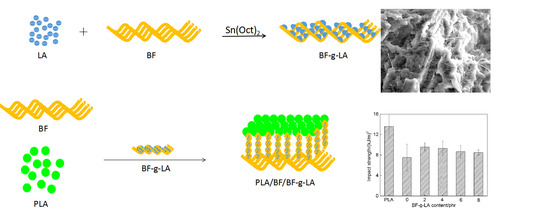Effect of Bamboo Flour Grafted Lactide on the Interfacial Compatibility of Polylactic Acid/Bamboo Flour Composites
Abstract
:1. Introduction
2. Experimental Procedure
2.1. Materials and Reagents
2.2. Principal Equipment Used
2.2.1. Grafting Reaction
2.2.2. Blending
2.3. Sample Preparation
2.3.1. Preparation of BF-g-LA
2.3.2. Preparation of PLA/BF/BF-g-LA Composites
2.4. Performance Testing and Characterization
2.4.1. Determination of BF-g-LA Content
2.4.2. Thermogravimetric Analysis of BF-g-LA Modified PLA/BF Composites
2.4.3. Testing of Mechanical Properties
2.4.4. Scanning Electron Microscopy
3. Results and Discussion
3.1. Characterization of BF-g-LA
3.1.1. Infrared Spectroscopy
3.1.2. Elemental Analysis
3.2. Effect of BF-g-LA on the Thermal Properties of Composites
3.3. Effect of BF-g-LA on the Mechanical Properties of Composites
3.4. Effect of BF-g-LA on the Morphology of the Fracture Surface of the Composites
4. Conclusions
Acknowledgments
Author Contributions
Conflicts of Interest
References
- Dorez, G.; Taguet, A.; Ferry, L.; Lopez-Cuesta, J.M. Thermal and fire behavior of natural fibers/PBS biocomposites. Polym. Degrad. Stabil. 2013, 98, 87–95. [Google Scholar] [CrossRef]
- Zhou, Y.X.; Huang, Z.G.; Diao, X.Q.; Weng, Y.X.; Wang, Y.Z. Characterization of the effect of REC on the compatibility of PHBH and PLA. Polym. Test. 2015, 42, 7–25. [Google Scholar] [CrossRef]
- Tsuji, H.; Sasaki, H.; Sato, H.; Gotoh, Y.; Ishikawa, J. Neuron attachment properties of carbon negative-ion implanted bioabsorbable polymer of poly-lactic acid. Nucl. Instrum. Methods Phys. Res. Sect. B 2002, 191, 815–819. [Google Scholar] [CrossRef]
- Tarvainen, T.; Karjalainen, T.; Malin, M.; Pohjolainen, S.; Tuominen, J.; Seppala, J.; Jarvinen, K. Degradation of and drug release from a novel 2,2-bis(2-oxazoline) linked poly(lactic acid) polymer. J. Control. Release 2002, 81, 251–261. [Google Scholar] [CrossRef]
- Gao, C.L.; Xia, Y.Z.; Ji, Q. Study on modification of polylactic acid. Mater. Rev. 2006, 20, 372–374. [Google Scholar]
- Lv, S.; Gu, J.; Tan, H.; Zhang, Y. Modification of wood flour/PLA composites by reactive extrusion with maleic anhydride. J. Appl. Polym. Sci. 2016, 13. [Google Scholar] [CrossRef]
- Chuayjuljit, S.; Wongwaiwattanakul, C.; Chaiwutthinan, P.; Prasassarakich, P. Biodegradable poly(lactic acid)/poly(butylene succinate)/wood flour composites: Physical and morphological properties. Polym. Compos. 2016. [Google Scholar] [CrossRef]
- Liu, R.; Cao, J.; Peng, Y.; Chen, Y. Physical, mechanical, and thermal properties of micronized organo-montmorillonite suspension modified wood flour/poly(lactic acid) composites. Polym. Compos. 2015, 36, 731–738. [Google Scholar] [CrossRef]
- Liu, R.; Peng, Y.; Cao, J. Thermal stability of organo-montmorillonite-modified wood flour/poly(lactic acid) composites. Polym. Compos. 2016, 37, 1971–1977. [Google Scholar] [CrossRef]
- Sajna, V.P.; Mohanty, S.; Nayak, S.K. A study on thermal degradation kinetics and flammability properties of poly (lactic acid)/banana fiber/nanoclay hybrid bionanocomposites. Polym. Compos. 2015. [Google Scholar] [CrossRef]
- Ali Nezamzadeh, S.; Ahmadi, Z.; AfshariTaromi, F. From microstructure to mechanical properties of compatibilizedpolylactide/thermoplastic starch blends. J. Appl. Polym. Sci. 2017. [Google Scholar] [CrossRef]
- Gunti, R.; Ratna Prasad, A.V.; Gupta, S. Preparation and properties of successive alkali treated completely biodegradable short jute fiber reinforced PLA composites. Polym. Compos. 2015, 37, 2160–2170. [Google Scholar] [CrossRef]
- Gunti, R.; Ratna Prasad, A.V.; Gupta, S. Mechanical and degradation properties of natural fiber reinforced PLA composites: Jute, sisal, and elephant grass. Polym. Compos. 2016. [Google Scholar] [CrossRef]
- Jiang, A.; Xu, X.; Wu, H. Preparation and properties of l-lactide-grafted sisal fiber–reinforced poly(lactic acid) composites. Polym. Compos. 2016, 37, 802–809. [Google Scholar] [CrossRef]
- Prasad, C.V.; Sudhakara, P.; Prabhakar, M.N.; Shah, A.U.R.; Song, J.I. An Investigation on the Effect of Silica Aerogel Content on Thermal and Mechanical Properties of Sisal/PLA Nano Composites. Polym. Compos. 2016. [Google Scholar] [CrossRef]
- Arjmandi, R.; Hassan, A.; Eichhorn, S.J.; Haafiz, M.K.M.; Zakaria, Z.; Tanjung, F.A. Enhanced ductility and tensile properties of hybrid montmorillonite/cellulose nanowhiskers reinforced polylactic acid nanocomposites. J. Mater. Sci. 2015, 50, 3118–3130. [Google Scholar] [CrossRef] [Green Version]
- Gu, S.Y.; Zou, C.Y.; Zhou, K.; Ren, J. Structure-rheology responses of polylactide/calcium carbonate composites. J. Appl. Polym. Sci. 2009, 114, 1648–1655. [Google Scholar] [CrossRef]
- De Almeida, J.F.M.; da Silva, A.L.N.; Escócio, V.A.; da Silva, A.H.M.D.F.T.; de Sousa, A.M.F.; Nascimento, C.R.; Bertolino, L.C. Rheological, mechanical and morphological behavior of polylactide/nano-sized calcium carbonate composites. Polym. Bull. 2016, 73, 1–15. [Google Scholar] [CrossRef]
- Picard, E.; Espuched, E.; Fulchiron, R. Effect of an organo-modified montmorillonite on PLA crystallization and gas barrier properties. Appl. Clay Sci. 2011, 53, 58–65. [Google Scholar] [CrossRef]
- Wang, Y.N.; Weng, Y.X.; Wang, L. Characterization of interfacial compatibility of polylacticacid and bamboo flour (PLA/BF) in biocomposites. Polym. Test. 2014, 36, 119–125. [Google Scholar] [CrossRef]
- Kang, J.T.; Park, S.H.; Kim, S.H. Improvement in the adhesion of bamboo fiber reinforced polylactidecomposites. J. Compos. Mater. 2014, 48, 2567–2577. [Google Scholar] [CrossRef]
- Wang, H.; Sheng, K.C.; Chen, J.; Mao, H.L.; Qian, X.Q. Mechanical and thermal properties of sodium silicate treated moso bamboo particles reinforced PVC composites. Sci. China Technol. Sci. 2010, 53, 2932–2935. [Google Scholar] [CrossRef]
- Lu, T.; Liu, S.; Jiang, M.; Xu, X.; Wang, Y.; Wang, Z.Y.; Gou, J.; Hui, D.; Zhou, Z.W. Effects of modifications of bamboo cellulose fibers on the improved mechanical properties of cellulose reinforced poly(lactic acid) composites. Compos. Part B Eng. 2014, 62, 191–197. [Google Scholar] [CrossRef]
- Lee, B.H.; Lee, J.W.; Lee, K.W.; Kim, C.W.; Kim, K.S.; Kim, Y.C. Effects of Ethylene-Octene Copolymer and Alkali Treatment of Bamboo Fiber (BF) on the Physical Properties of PP/BF Composites. Polymer 2016, 40, 607–613. [Google Scholar] [CrossRef]
- Xu, X.L.; Zhang, M.; Qiang, Q.; Song, J.Q.; He, W.Q. Study on the performance of the acetylated bamboo fiber/PBS composites by molecular dynamics simulation. J. Compos. Mater. 2015, 50, 995–1003. [Google Scholar] [CrossRef]
- Ochi, S. Flexural Properties of Long Bamboo Fiber/ PLA Composites. Open J. Compos. Mater. 2015, 5, 70–78. [Google Scholar]
- Gupta, A. Synthesis, chemical resistance, and water absorption of bamboo fiber reinforced epoxy composites. Polym. Compos. 2016, 37, 141–145. [Google Scholar] [CrossRef]
- Li, J.; Lu, X.L.; Zheng, Y.F. Effect of surface modified hydroxyapatite on the tensile property improvement of HA/PLA composite. Appl. Surf. Sci. 2008, 255, 494–497. [Google Scholar] [CrossRef]
- Shen, C. Determination of Vapor-Liquid Equilibrium and Thermodynamics Model of Methanol-Ethanol-Water-Ionic Liquid System; Beijing University of Chemical Technology: Beijing, China, 2011. [Google Scholar]
- Gong, X.; Xi, J.K.; Wu, H.W. Mechanical properties of sisal fiber reinforced polylactic acid biodegradable composites. Plastics 2010, 3, 26–29. [Google Scholar]
- Li, X.G.; Wu, Y.Q.; Zheng, X.; Qin, H.Y. Advances in Research on Compatibility of Plant Fibers with Biodegradable Plastics. Plast. Technol. 2009, 37, 86–89. [Google Scholar]
- Zhou, X.X.; Huang, S.S.; Chen, L.H.; Lin, Q.J. Water Absorbency and Surface Wettability of Polypropylene Composites Reinforced with Bamboo Powder. J. Fujian Agric. For. Univ. Nat. Sci. Ed. 2012, 41, 208–212. [Google Scholar]

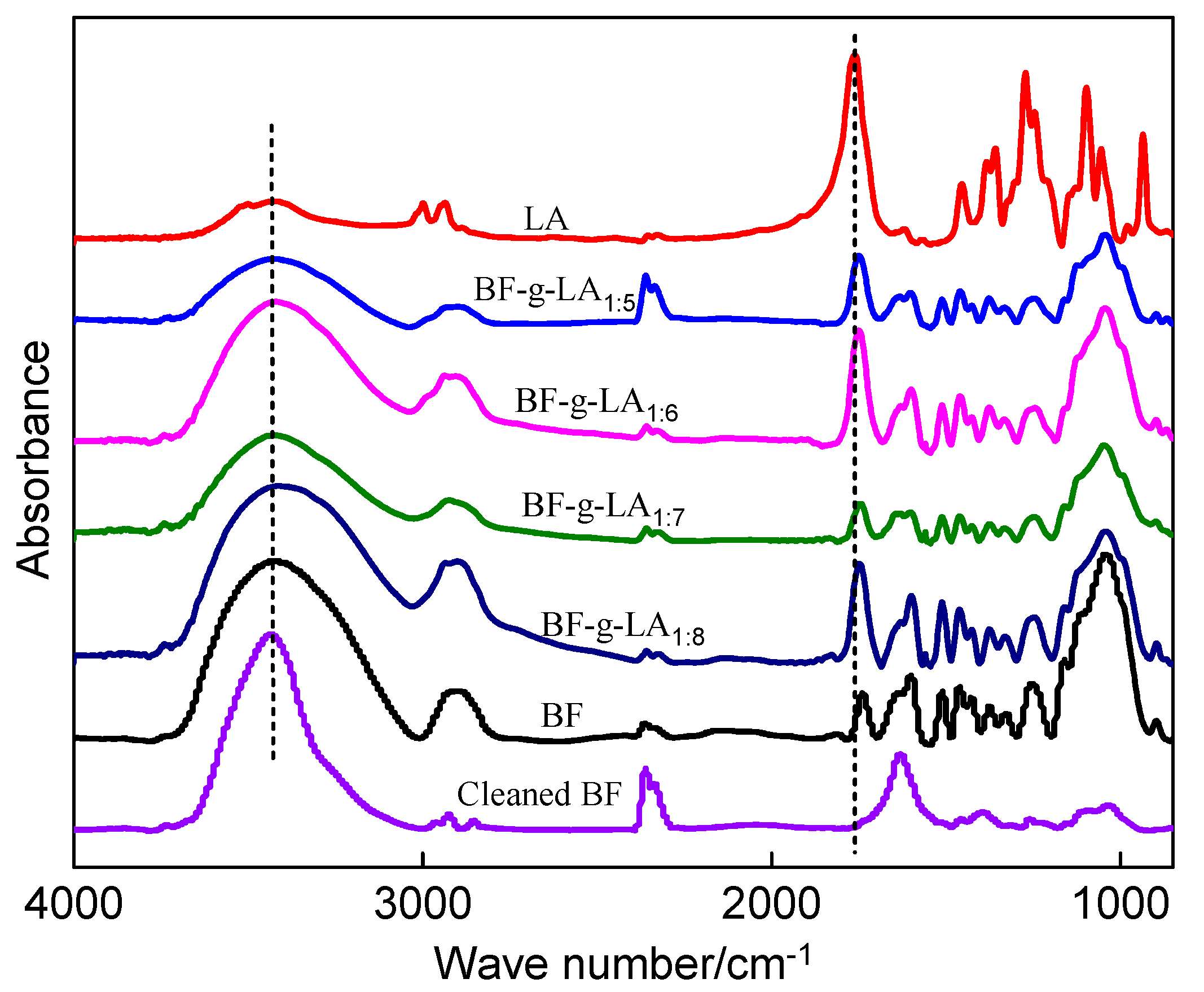


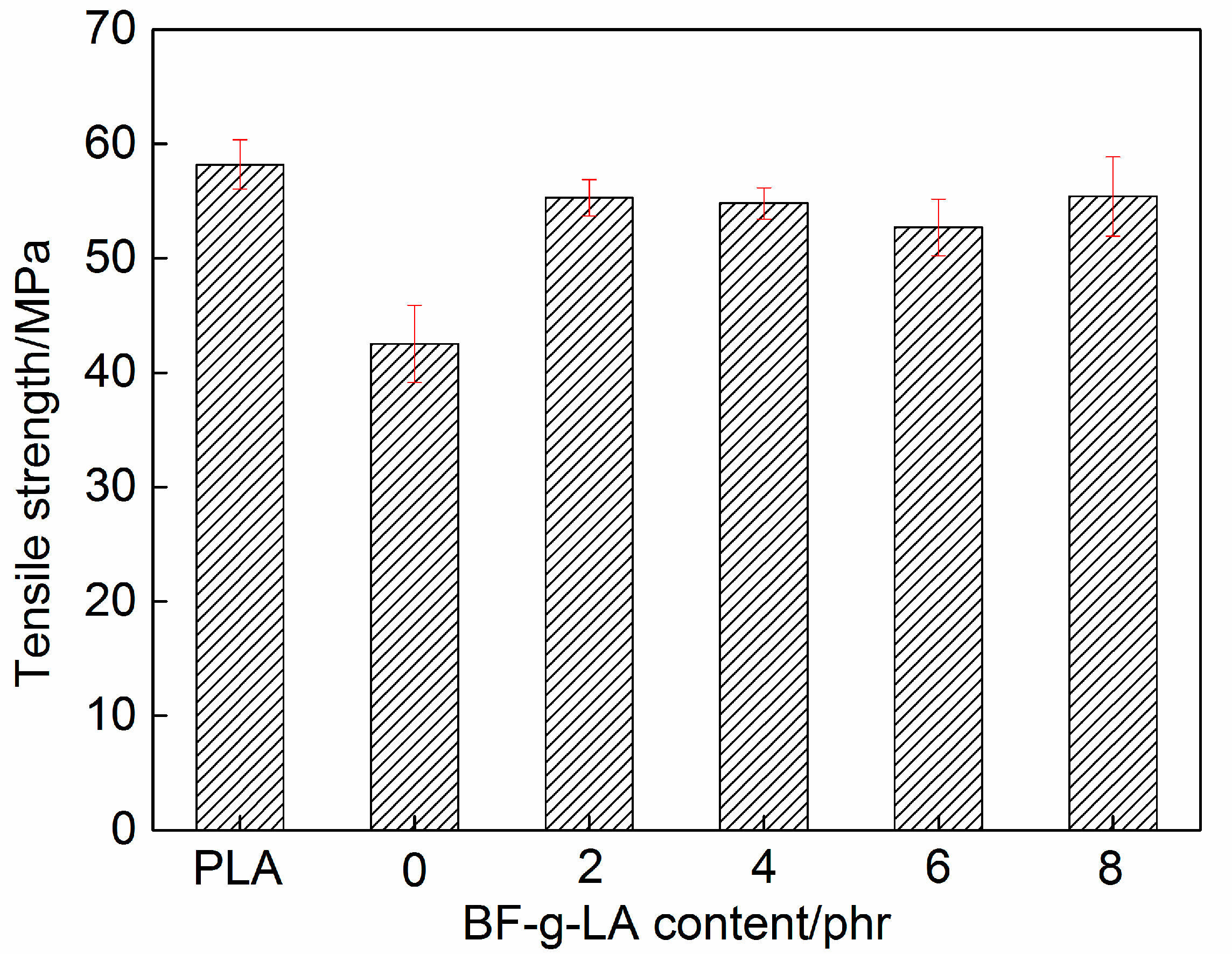
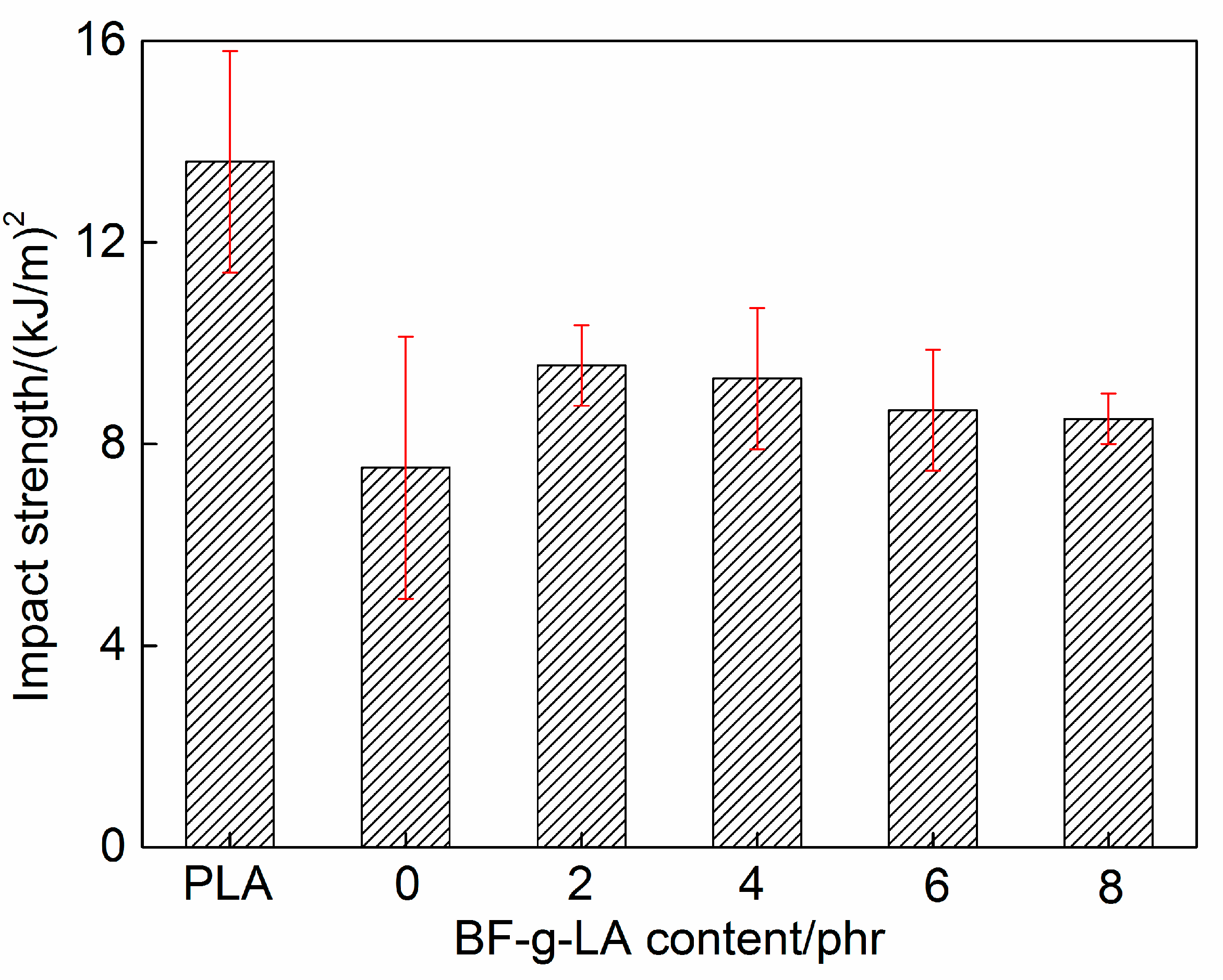
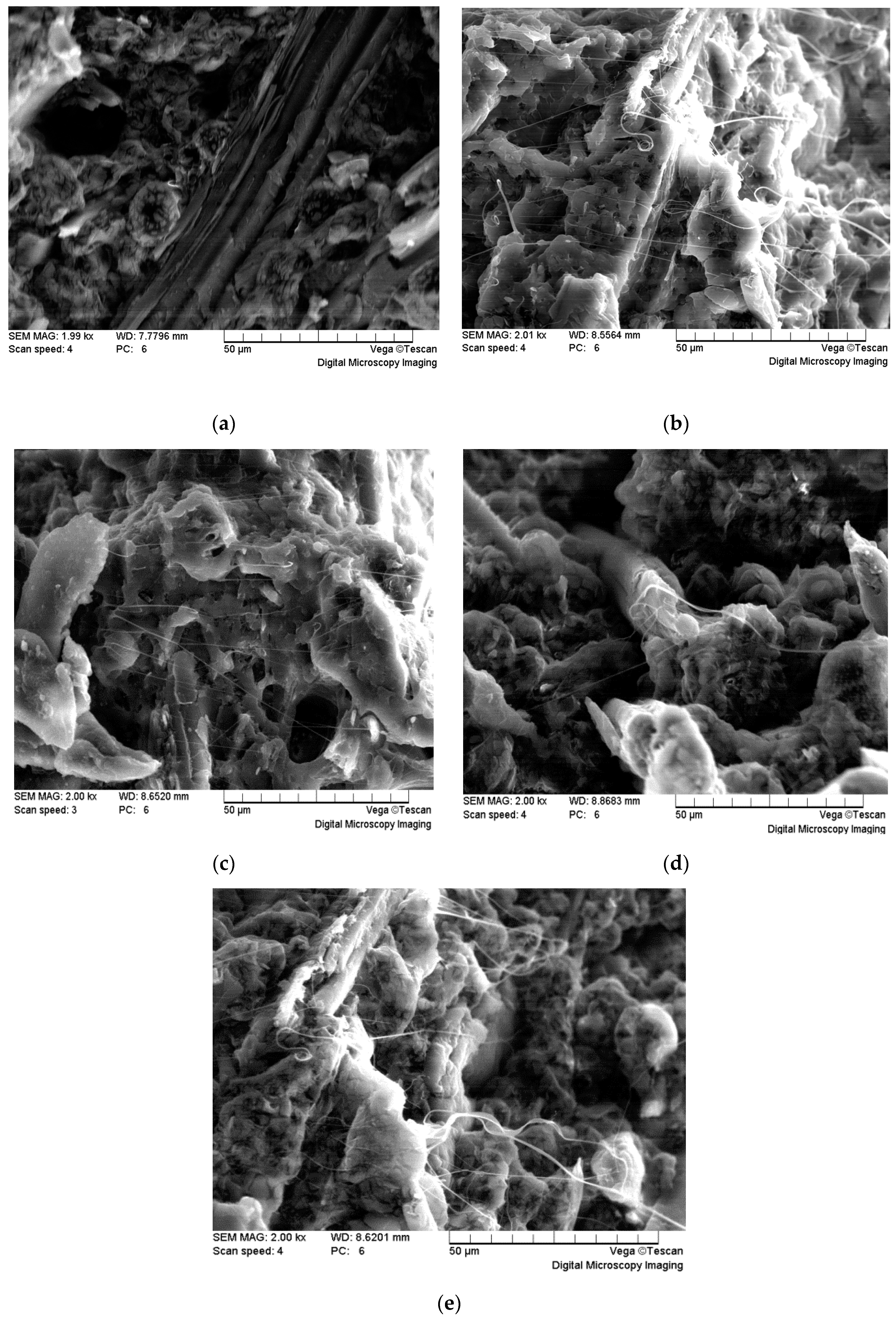
| Grafting Product Abbreviation | BF/LAMmass Ratio (WBF/WLA) | Reaction Temperature (T/°C) | Stirring Speed (v/r·min−1) | Reaction Time (t/h) | ||||||
|---|---|---|---|---|---|---|---|---|---|---|
| TMelt | Tswell | Treaction | vmelt | vswell | vreaction | tmelt | tswelling | treaction | ||
| BF-g-LA1:5 | 1:5 | 100 | 100 | 110 | 150 | 180 | 220 | 1 | 5 | 6 |
| BF-g-LA1:6 | 1:6 | 100 | 100 | 110 | 150 | 180 | 220 | 1 | 5 | 6 |
| BF-g-LA1:7 | 1:7 | 100 | 100 | 110 | 150 | 180 | 220 | 1 | 5 | 6 |
| BF-g-LA1:8 | 1:8 | 100 | 100 | 110 | 150 | 180 | 220 | 1 | 5 | 6 |
| PLA/wt % | BF/wt % | BF-g-LA/phr | Antioxidant/phr |
|---|---|---|---|
| 85 | 15 | 0 | 1 |
| 85 | 15 | 2 | 1 |
| 85 | 15 | 4 | 1 |
| 85 | 15 | 6 | 1 |
| 85 | 15 | 8 | 1 |
| Wave Number/cm−1 | Group |
|---|---|
| 3500 | Hydroxyl O–Hstretching vibration |
| 1740–1762 | Carbonyl C=O stretching vibration |
| 1425, 1460 | C–H bending, stretching vibration |
| 1330 | Benzene ring stretching vibration |
| Concentration | LA | BF | Cleaned BF by Chloroform | BF-g-LA1:5 | BF-g-LA1:6 | BF-g-LA1:7 | BF-g-LA1:8 |
|---|---|---|---|---|---|---|---|
| C wt % | 48.80 ± 0.08 | 49.83 ± 0.26 | 49.26 ± 0.18 | 48.86 ± 0.09 | 48.91 ± 0.13 | 48.97 ± 0.06 | 49.02 ± 0.04 |
| Samples | 5% Weight-Loss Temperature/°C | DTG Peak Temperature/°C |
|---|---|---|
| BF | 251 | 358 |
| Cleaned BF by chloroform | 224 | 349 |
| BF-g-LA1:5 | 205 | 346 |
| LA | 136 | 205 |
| Samples | 5% Weight-Loss Temperature/°C | DTG Peak Temperature/°C |
|---|---|---|
| neat PLA | 341 | 373 |
| PLA/BF/BF-g-LA-0phr | 302 | 353 |
| PLA/BF/BF-g-LA-2phr | 313 | 362 |
| PLA/BF/BF-g-LA-4phr | 311 | 361 |
| PLA/BF/BF-g-LA-6phr | 312 | 362 |
| PLA/BF/BF-g-LA-8phr | 309 | 364 |
© 2017 by the authors. Licensee MDPI, Basel, Switzerland. This article is an open access article distributed under the terms and conditions of the Creative Commons Attribution (CC BY) license (http://creativecommons.org/licenses/by/4.0/).
Share and Cite
Song, X.-y.; Wang, M.; Weng, Y.-x.; Huang, Z.-g. Effect of Bamboo Flour Grafted Lactide on the Interfacial Compatibility of Polylactic Acid/Bamboo Flour Composites. Polymers 2017, 9, 323. https://doi.org/10.3390/polym9080323
Song X-y, Wang M, Weng Y-x, Huang Z-g. Effect of Bamboo Flour Grafted Lactide on the Interfacial Compatibility of Polylactic Acid/Bamboo Flour Composites. Polymers. 2017; 9(8):323. https://doi.org/10.3390/polym9080323
Chicago/Turabian StyleSong, Xin-yu, Meng Wang, Yun-xuan Weng, and Zhi-gang Huang. 2017. "Effect of Bamboo Flour Grafted Lactide on the Interfacial Compatibility of Polylactic Acid/Bamboo Flour Composites" Polymers 9, no. 8: 323. https://doi.org/10.3390/polym9080323




